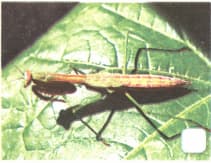Choose from the help box to name these animals. Write the correct letters to match the descriptions with the animal.
(praying mantis racoon flamingo squirrel beaver bacterian camel hedgehog)

a. When this prickly, spiny mammal curls up to go to sleep, it's for protection. Its body is covered with prickly spines everywhere except on the face, legs and belly.
b. This little mammal has claws to climb trees and to grasp things. It has teeth to crack open nuts. These are physical adaptations. We have often noticed it running up a tree as soon as we approach it. This is a behavioural adaptation.
c. It has two humps on its back where it stores fat. Because it stores fat only in its humps, it has developed special adaptations to help it face both harsh winter and summer. It has a thick, bushy coat that protects it in winter and which it sheds as the temperature begins to rise in summer. This is known as moulting.
d. It has sharp claws to climb tall trees. The black marks under its eyes help it to block out the Sun and also to camouflage against its predator.
e. It is well adapted to life in the water. Its tail helps it to swim and its thick coat of fur keeps it warm in cold water. These are examples of physical adaptations because it did not learn these, but was born with them.
f. It runs on water, on its webbed feet, to gain speed before lifting into the sky. Using its upper beak like a shovel, it scoops fish from lakes. A series of hair-like growth inside its beak acts as a filter and separates food from muddy water.
g. This insect can turn its head into an entire half-circle. It has excellent eyesight that helps it spot prey. It is well-camouflaged, adapting colours that help it blend with the leaves and twigs it lives on. Its front legs have rows of sharp spines to help it hold on to its prey.
(praying mantis racoon flamingo squirrel beaver bacterian camel hedgehog)

b. This little mammal has claws to climb trees and to grasp things. It has teeth to crack open nuts. These are physical adaptations. We have often noticed it running up a tree as soon as we approach it. This is a behavioural adaptation.
c. It has two humps on its back where it stores fat. Because it stores fat only in its humps, it has developed special adaptations to help it face both harsh winter and summer. It has a thick, bushy coat that protects it in winter and which it sheds as the temperature begins to rise in summer. This is known as moulting.
d. It has sharp claws to climb tall trees. The black marks under its eyes help it to block out the Sun and also to camouflage against its predator.
e. It is well adapted to life in the water. Its tail helps it to swim and its thick coat of fur keeps it warm in cold water. These are examples of physical adaptations because it did not learn these, but was born with them.
g. This insect can turn its head into an entire half-circle. It has excellent eyesight that helps it spot prey. It is well-camouflaged, adapting colours that help it blend with the leaves and twigs it lives on. Its front legs have rows of sharp spines to help it hold on to its prey.
Important Questions on Ear to Ear
_____ lay eggs in their nests. (Birds/ Monkeys)
Fish reproduces by _____. [giving birth/laying eggs]
_____ lay eggs in sand or soil.
How are bat and whale similar?
Define/Explain:
Herbivores
